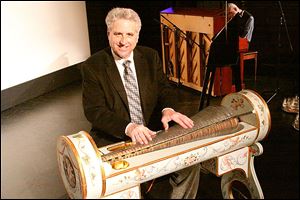
Musician's art is performed on the stage
7/25/2012
Musician Dennis James with his glass armonica.
Twenty minutes before his performance with an orchestra in Naples, Italy, Dennis James learned the concert would be televised throughout Europe.
When intense camera lights were trained on him, he began to perspire: That would bother most musicians, but it's calamitous for an armonica player. Simply touching his face or hand results in traces of body oil on his fingertips, all it takes for the ethereal sound of the glass instrument to be corrupted.
So here's what the pro did: He pretended to play. He wet his fingers in water, moved them just above the turning glass bowls, and danced them around without ever touching the bowls. He even nodded to the conductor at appropriate moments. Without playing a note, he won a standing ovation and superlative newspaper reviews for "incomparable technique and subtlety." Subtlety indeed.
Assuming the lights aren't hot and the Toledo Museum of Art's Great Gallery is cool, Mr. James, 62, will play his made-for-him armonica (pronounced ar-MOAN-ica), at 7:30 p.m. Friday. He'll punctuate the free performance with humorous anecdotes collected through his 40-year musical career: Think Peter Schickele and P.D.Q. Bach. Mr. James spoke with The Blade from JFK International Airport last week.
IF YOU GO
Dennis James will discuss and perform on his glass armonica at a free concert, 7:30 p.m. Friday, in the Great Gallery of the Toledo Museum of Art.
Mr. James, who plays more than 300 instruments including pipe organ, has made six recordings, and is a member of Linda Ronstadt's band, will play several pieces from the 538-piece repertoire written for armonica, including Mozart's Adagio in C, which, along with Donizetti's Lucia di Lammermoor has kept the instrument alive (and a Viennese family producing the instrument) for 200 years.
During a concert in Germany, he asked the ensemble to play very quietly. They didn't and he struggled to get more sound out of the armonica.
"I played too hard and cut myself," he said. "Blood just flew everywhere. It was unbelievable."
The armonica tale began 250 years ago with Benjamin Franklin. He was in his mid-50s when he was posted to England and in 1761, he heard exquisite melodies made by rubbing the rims of water-filled wine glasses. Enchanted, he designed and worked with a London glassblower to build an instrument that had 37 bowls of increasing size, capable of range and nuance; they were mounted horizontally on an iron spindle that turned by means of a foot pedal. Like wine glasses, sound was produced by touching the rims of the turning bowls with moistened fingers; better than wine glasses, up to 10 bowls could be played simultaneously. He called it armonica, Italian for harmony.
The instrument Mr. James will drive from his Corning, N.Y., home to Toledo will be fitted with 47 bowls, each worth about $1,800. Replacement cost for the whole she-bang: $91,000. He'll also bring 35 brandy snifters, tune them with varying amounts of water, and ask audience members to play them.
He's driven coast to coast to concerts since security rules in the wake of 9/11 made it illegal to carry his armonica on an airplane. He shipped it once and it arrived with $16,000 in damage and six weeks of performance downtime.
"I've entered the psychological territory of knowing it's normal for glass to break and it's a gift when it doesn't break."
For international flights, he packs it in two cases (one looks like a rifle case); he shows it to captains, gives them one of his CDs, and tells them if they don't let him carry them on, he'll wait for the next flight. "They always say yes."
He was an organ student when a professor mentioned the armonica, and Mr. James asked what it sounded like. Nobody knows, the teacher said; it hasn't been played in 200 years. The idea rooted in his imagination and he spent two days calling museums, asking where he could find one. The name Dominick Labino, an inventor and glass maker living near Toledo, came up repeatedly. Mr. Labino had repaired and rebuilt antique armonicas for museums, a process so difficult, he spent a year crafting a replica of Franklin's invention for himself. It's now owned by the Toledo museum.
The two met and became friends. "The first one I touched was Dominick Labino's."
When the elder man was dying, Mr. James visited him.
"He looked me in the eye and said 'I'm not giving you my armonica and you're probably wondering why.' He said, 'I know you, and you'll mess with it for a few months and move on. But if you have to build one, it will be a commitment and you'll play it well.' " Mr. Labino did give him some extra glass bowls he'd made.
Mr. James contacted more than 100 specialists worldwide: glass blowers and engravers, instrument designers, case-makers. "All said it couldn't be done," Mr. James said. "There were numerous problems with Ben Franklin's [invention] so I copied one first made in 1815."
He began playing it in 1981 and felt he'd mastered it ten years later.
He's given hundreds of performances and talks, composed pieces, played on albums by Ronstadt, Dolly Parton, Emmylou Harris, and for several film soundtracks. Believing he's succeeded in pulling this fragile instrument out of the footnotes and margins of history, it continues to be his passion.
"I play the organ for my stomach. I play the armonica for my heart."
Contact Tahree Lane at tlane@theblade.com or 419-724-6075.